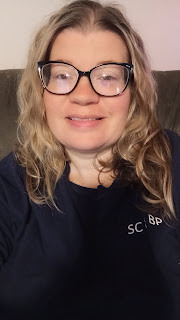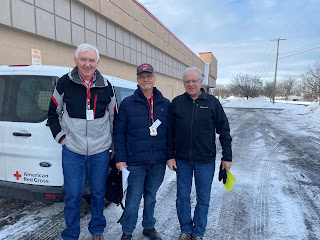(Above, from left to right: Volunteer Transportation Specialists Dean Stanley, Vic Pascell and Tony Addotta arrive for their shifts in Buffalo at the conclusion of the storm.)In late December, the greater Buffalo region was devastated
by a blizzard of historic proportion.
Freezing temperatures, large accumulations of snow, and gale-force winds
made for dangerous and unpassable roads, essentially bringing travel to a stop,
even for first responders. After earlier warnings that week of a “once in a
generation” storm about to hit the area, it arrived on Friday, December 23, as
the region prepared for a holiday weekend. By early afternoon, high winds and
heavy snowfall created near white-out conditions.
While travel may have stopped, the need for blood to treat
trauma victims and other patients at area hospitals did not and, as an
organization that provides blood to every hospital in our region, the Red Cross
is an important cog in the cycle of blood collection and distribution. So, when
weather forecasts started to paint a picture of the intensity of the oncoming
storm and the challenges the region would face, several Red Cross volunteer
transportation specialists took it upon themselves to find ways to ensure that
the flow of life-saving blood products would continue to reach those in need.
As an organization that prides itself on emergency
preparedness, the Red Cross was fortunate to have dedicated volunteer transportation
specialists like Tony Addotta, Marc Smith, Benjamin “Frank” Murphy, Victor
Pascell, John Gnann, Rich VanDerMeid, David Andolora and Dean Stanley on hand
to plan and manage alternate methods of making on time deliveries to the
hospitals they served.
Anthony (Tony) Addotta, a Buffalo-based volunteer
driver, exemplified the mission-driven focus of the American Red Cross. As the
blizzard was getting ready to hit Erie County, Tony stated he still wanted to
deliver to hospitals, which would surely need blood ahead of the storm. He
arrived at the Union Road Blood Donation Center in Cheektowaga early on
December 23 to make the drive to Rochester to pick up and transport processed
blood products to Buffalo as early as possible. Tony worked in collaboration
with other drivers to split up the hospital deliveries that day, with each
focusing on a specific section of Erie County to save time and get safely back
home before the storm became too severe. Tony’s list included many of the hospitals
in the City of Buffalo.
After the storm, when travel bans remained in place and many
roads were impassable, Tony came in on December 28 and 29 and helped create
routes for multiple volunteer drivers so that blood could be delivered safely
via alternate, creative routes/roads that were deemed safe. He delivered to
hospitals in contained sections in the City of Buffalo on those days and made
an immense difference delivering life-saving blood products to hospitals during
a stressful time, always with a smile for our customers!
Marc Smith, in his third year of serving as a Red
Cross volunteer, was also instrumental in getting blood to hospitals before the
storm hit. Marc came in on December 23 as the snow and wind were starting to
intensify. To get drivers off the road as early as possible, one route up was
split up among three different drivers. Marc took his own vehicle to
deliver blood to Bertrand Chaffee hospital in Springville. His timely and
creative action likely prevented the originally scheduled driver from being stranded
in the blinding snowstorm that quickly settled in over Erie County. He was also
instrumental in getting blood to a rural hospital that ended up being blocked
off by snow drifts, stranded vehicles, and road closures for several days.
Benjamin “Frank” Murphy is another Buffalo-area
volunteer who was instrumental in helping to deliver blood ahead of the storm’s
catastrophic impact. Frank came in early ahead of the storm to collaborate with
other volunteers and help split up the normal hospital delivery route. The
team’s goal that morning was to get drivers off the road as early as possible in
light of the oncoming, severe storm, while still ensuring hospitals received
the life-saving blood product that they needed. Frank used his own vehicle to
bring blood to a hospital that was not on the usual delivery list, but which
needed blood products that morning. The hospital was located some distance from
the rest of the facilities on the list and, in the previously scheduled route, would
have taken the normal driver too long to safely get to ahead of the storm.
As the storm finally receded by December 28, Vic Pascell
was the first Buffalo volunteer back on the road to transport blood. At this
point, numerous roads near hospitals and the roads that were normally used for
transport were still closed. Vic left early on the first day the New York State
Thruway reopened to drive to Rochester, where all blood donations are
processed, and pick up blood to bring back to Cheektowaga. He communicated the
exact hospital orders and box numbers to facilitate collaboration with other
volunteers. Due to remaining road closures and travel restrictions, hospital
deliveries were again split between three drivers. Vic traveled in areas in
Northern Buffalo and nearby suburbs to deliver blood to hospitals, navigating
through streets in which plows were still struggling to clean-up snow and
abandoned vehicles.
Buffalo volunteer Dean Stanley was eager to come in
and help transport blood as soon as access was available to the Union Road
Blood Donation Center. When word came that the Blood Donation Center could open
on Wednesday, December 28, nearly a week after the storm hit, communication
went out to the transportation team asking for volunteers to come in and help
transport blood. The e-mail went out just before 5:00 a.m and Dean was at the
Union Road location in Cheektowaga by 8:30.
After arriving, he helped divide the usual route so that volunteers
could focus on small areas of Erie County that were accessible while numerous
roads still had to be plowed and cleared of abandoned vehicles. Dean’s route
included going to Bertrand Chaffee in Springville, which for several days could
not get blood while all major roads into the area were closed.
Just one day later, December 29, John Gnann reported
for his usual Thursday morning hospital deliveries. Despite the fact that there
remained many unknowns in terms of road conditions and closures, John was
determined to make sure hospitals received the necessary blood products. John worked
with his colleagues to split normal hospital route deliveries between two
volunteers. After driving from Buffalo to West Henrietta to pick-up blood, he
sent a message with the official number of boxes for each hospital so that
final plans could be made for delivery.
While Rochester was spared the brunt of Winter Storm
Elliott, Rochester-based drivers pitched in to help their colleagues in
Buffalo. While Erie County remained
completely closed off, Rich VanDerMeid, a Red Cross volunteer of 13
years, was instrumental in getting blood to Buffalo hospitals. On Christmas
Day, the Erie County Sheriff’s Office (ECSO) notified the Red Cross that
traveling to Buffalo-area hospitals remained unsafe. To compensate for those
limitations, the transportation team planned to have an ECSO Deputy meet up
with a Rochester driver in Batavia. That evening, Transportation Supervisor Rachel Elzufon Couch texted Rich and, despite it being
Christmas, Rich called within minutes and the two discussed a new plan to help
Buffalo get blood. During his usual West Henrietta – West run, he volunteered
to take blood for Buffalo hospitals to give to the Erie County Sheriff’s
Office, meeting up at United Memorial Medical Center, in Batavia. Rich did this
without being able to use his typical route to Batavia, as the Thruway was still
closed from Rochester to the Pennsylvania line.
While Erie County remained completely closed off, David
Andolora, of Rochester, was instrumental in getting blood to Buffalo
hospitals. While a travel ban remained in place in Erie County, the Erie County
Sheriff’s Office told us that those hospitals remained difficult to access due
to numerous streets still unplowed and filled with abandoned vehicles. David
came in an extra day to make sure that Buffalo hospitals received blood, using
alternate routes because of the Thruway closure to bring product destined for
multiple Buffalo hospitals to Batavia, where he handed it off to a sheriff’s
deputy from Erie County. That deputy then delivered blood to hospitals in
Buffalo. David communicated effectively about which hospitals he had so that the
sheriff’s deputy fully understood which hospitals he needed to deliver to.
To a person, each of the volunteer drivers expressed a sense
of duty to make sure blood was available to hospitals and the patients that
depended on it, deflecting any praise of their efforts.
“I received a call from Rachel asking if I was available and
willing to help with the morning hospital deliveries,” Smith said. “I knew it
was going to be difficult driving with the storm coming in, but I was confident
I could be of help. The importance of making sure hospitals have the blood
supply they need is motivation…especially during adverse weather conditions.”
Vic Pascell concurred, saying, “I felt it was a small part
that I could contribute. I know the blood deliveries were important during that
time and I had the time and resources to help.”
For John Gnann, the potential consequences if there was a
disruption to the blood supply were unacceptable. “I was the one who was needed to make sure
the blood was delivered,” he said, referring to the hospitals to which he
delivered. “It was my job and people in my city were depending on me. This was
literally a life and death situation due to the serious disruption to the
supply chain in Buffalo because of the storm.”
Gnann was also quick to credit Transportation Supervisor Rachel
Elzufon Couch for her dedication and strong leadership in organizing delivery
efforts during trying times. “She (Rachel) was the quarterback, we were the
running backs.”
Rich VenDerMeid also cited Elzufon Couch’s leadership. “I knew that Rachel might have difficulty
finding someone else,” he said, noting that his family holiday plans were
scheduled for another day, allowing him to step forward.
A variety of closely linked themes were also expressed in
describing some of the challenges the historic storm and related conditions
presented.
While Smith joked that driving his own 4X4 pickup truck did
not help much with visibility, he said that it was helpful in getting through
drifts and snow that was quickly accumulating on roads. “The biggest
challenge…the complete white outs, snow drifts across the roads and through
intersections, and navigating a route to avoid the high elevations of the 219
expressway,” he recalled.” I volunteered to do the delivery to Springville
because having lived in the Southtowns snowbelt my whole life, I felt
comfortable enough that I could complete the delivery.”
For Pascell, Buffalo’s
storm response presented some obstacles. “The biggest challenge was finding
ways around some of the large pieces of snow removal equipment still operating
to clear some of the higher traveled streets in the city,” he said.
Gnann highlighted yet another issue. “The biggest challenge
I faced was making sure that the roads I normally take to get to the hospitals
were open. I had to make a couple of detours, but it all worked out.”
It was Smith who captured the can-do attitude of Red Cross
volunteers, in this particular emergency, and in the various disasters to which
they respond in the Western New York Region:
“I didn’t feel like it was above and beyond, said Smith. “If
they need me, I’ll do what I can to help.”
















